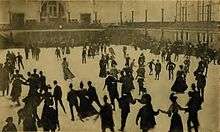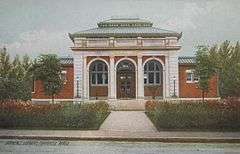Walter B. Chambers
| Walter B. Chambers | |
|---|---|
|
Chambers's Bingham Hall (1928) at Yale University | |
| Born |
Walter Boughton Chambers September 15, 1866 Brooklyn, New York, U.S. |
| Died |
April 19, 1945 (aged 78) New York City, New York, U.S. |
| Nationality | American |
| Education |
Ecole des Beaux Arts Yale University |
| Occupation | Architect, Educator |
| Employer | Flagg & Chambers (co-founder) |
| Known for |
Atelier Masqueray-Chambers (co-founder in 1893) St. Nicholas Skating Rink (1896) in New York City McClellan Hall (1925) on Yale University's Old Campus Bingham Hall (1928) on Yale University's Old Campus Singer Building (1908) Corcoran Gallery of Art (1897) in Washington, D.C. |
| Spouse(s) |
Ethel (Notman) Chambers (1897-1898) Elizabeth (Ferguson) Chambers (1901-1945) |
| Children |
Robert Notman Chambers Peter Ferguson Chambers William Hall Chambers |
| Parent(s) |
William Pease Chambers Caroline (Boughton) Chambers |
| Relatives | Robert W. Chambers (brother) |
| Honors | American Institute of Architects |
Walter Boughton Chambers, AIA (September 15, 1866 – April 19, 1945) was a successful New York City architect whose buildings continue to be landmarks in the city’s skyline and whose contributions to architectural education were far-reaching.
Childhood and education


Chambers was born in Brooklyn, New York, the son of attorney William P. and Caroline (Boughton) Chambers, both of whom were New York natives.[1] His family’s standing permitted him to attend Yale University, from which he graduated in 1887. At Yale he served on the fifteenth editorial board of The Yale Record[2] and was a member of the Scroll and Key Society.
Following his graduation Chambers went to Paris and entered the Ecole des Beaux Arts, where he studied at the atelier of Paul Blondel, along with his future architectural partner Ernest Flagg (1857-1947), a cousin of Cornelius Vanderbilt II.[3] He was also the brother of the American artist and writer, Robert W. Chambers.
Practice in New York
Returning to New York, Chambers formed a partnership with Ernest Flagg in 1894. In 1897 they moved into the Mills Building at 35 Wall Street, where they remained until 1919 when they moved to 111 East 40th Street. Usually, Ernest Flagg is credited with some of the work that emerged from their partnership, including, the Singer Building (the world’s tallest building from 1908-1909), the Corcoran Gallery of Art in Washington, D.C., the Washington State Capitol and the Sheldon Library at St. Paul's School (Concord, New Hampshire). Flagg also designed homes and stores for the Scribner book-publishing family (his sister Louisa married Charles Scribner[4]) and was a favorite architect of the Clark family, of the Singer Sewing Machine Company.[3]
Work attributed to Walter B. Chambers
Partial listing:[5]
- St. Nicholas Skating Rink, 69 West 66th Street, New York – 1896 [6][7]
- Fire Engine Company No 67 - 514 West 170th Street, New York – 1897
- The Oaks Plantation - Goose Creek, South Carolina - 1897 [8]
- Fire Engine Company No. 33 at 44 Great Jones Street, New York – 1899
- Lawrence Library, Pepperell, Massachusetts - 1901
- Mills House – 1902
- Apartment House - 563 Park Avenue, New York – 1908
- James R. Sheffield Residence (Gloria Vanderbilt Cooper Residence) at 45 East 67th Street, New York - 1913
- No. 1 Broadway, New York - International Merchant Marine Building - 1919-1921
- 1148 Fifth Avenue, New York (apartment house) - 1920
- 2 East 96th Street, New York (apartment house) - 1922-23
- McClellan Hall, Old Campus, Yale University, New Haven, Connecticut – 1925
- Bingham Hall, Old Campus, Yale University, New Haven, Connecticut – 1928
- 135 West 58th Street, New York (apartment house) - 1911
Atelier Masqueray-Chambers
In 1893, Walter B. Chambers joined with Franco-American architect Emmanuel Louis Masqueray to establish the first atelier for architectural studies in the United States based on the French Ecole des Beaux Arts system. Located at 123 East 23rd Street in New York, the Atelier Masqueray-Chambers helped educate many outstanding architects, including Leonard B. Schultze (architect of The Pierre, Sherry-Netherland and Waldorf Astoria Hotel) and William Van Alen (architect of the Chrysler Building).
Chambers was a member of the New York Chapter of the American Institute of Architects. He resided at 7 West 43rd Street, New York, and died in New York City, aged seventy-eight. His brother Robert W. Chambers, born 1865, was a noted artist, illustrator and writer.[3]
References
- ↑ 1880 U. S. Census
- ↑ "Record Editors". The Yale Banner. New Haven: Thomas Penney and G. D. Pettee. 1877. p. 182.
- 1 2 3 Who’s Who in America, 1906
- ↑ Descendants of Bartholomew Flagg - Eighth Generation Flagg Genealogy.
- ↑ Various sources, chiefly New York Times articles about the individual buildings, or the websites of said buildings
- ↑ White, Norval; Willensky, Elliot; Leadon, Fran, AIA Guide to New York City, Oxford University Press, 2010. Cf. p. 358.
- ↑ "STREETSCAPES: A Skating Rink/Boxing Ring, And a Wild and Crazy Facade", The New York Times, February 6, 2005
- ↑ "The Oaks: A Restored Mansion of the Old South" Country Life, December 1915